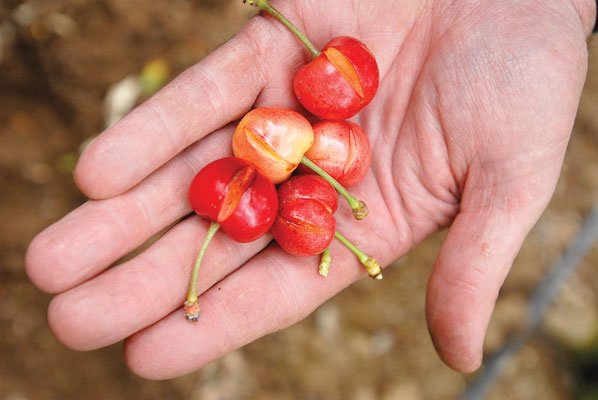
April showers might bring May flowers, but May showers pose a
major threat when it comes to local cherry and hay crops.
That’s why some farmers are scrapping their crop this week
following several late-season storms.
April showers might bring May flowers, but May showers pose a major threat when it comes to local cherry and hay crops.
That’s why some farmers are scrapping their crop this week following several late-season storms.
“Cherries is a one-shot thing,” Morgan Hill grower Andy Mariani said. “All your eggs are in a basket. And someone runs over your basket, and that’s it.”
Mariani plans to not pick most of his cherries this year, saying that it would cost as much or more to pick and pack them as he would make selling them. He lost at least 40 percent of his crop in the past few days, he said.
He may harvest a tiny portion of his crop for his fruit stand, but that will be insignificant, he said.
Similarly, Ralph Santos of Gilroy-based El Camino Produce estimated Wednesday that at least 30 to 50 percent of his cherry crop was destroyed by Tuesday’s rains alone.
The problem was that the rain was steady and lasted into Tuesday evening, Santos said. As a result, workers did not have a chance to start blowing off the water until about 5 a.m. Wednesday and water seeped into the cherries, causing them to crack.
“The problem is the cherries stayed too wet for too long a period of time,” he said.
Cherries are most susceptible to rain damage when they go from pink to red, Mariani said. Those fruits that have the most sugar inside are the ones that tend to crack first, he said.
Although Mariani said crop insurance will pay for some of the growing costs, he is looking at a huge loss this year.
“My bread and butter, my mainstay, is cherries, so it’s gonna hurt. But that’s the way it is,” he said.
On the other hand, he guessed cherry growers in Hollister would not have nearly as difficult of a time as many of those cherries are still in the green stage. He also did not know what type of damage orchards in the Stockton and Lodi had suffered. Even in South County, some growers fared better than others, Mariani said.
As a result of such unknowns, it is difficult to know whether the inclement weather will have an overall impact on cherry prices, he said.
Recent rains also have created problems for local hay growers.
By this time of year, Morgan Hill hay farmer Micheal Bernal has usually finished cutting, harvesting and bailing the 250 acres he works, he said. However, he has had to continue waiting until he is certain he has a string of consecutive dry days. After cutting hay fields, the grass needs eight to 10 days to dry before it can be bailed, he said.
“If you cut it and it’s laying on the ground and it gets rained on, it gets moldy and the animals don’t want to eat it,” Bernal said.
Other hay farmers in South County didn’t wait, and Bernal said he has heard of rain-related problems from local colleagues in recent weeks.
Another problem at hay farms directly related to this waiting game occurs on fields with “volunteer hay” – wild hay different from planted hay – Bernal said. By this late in the season, the seeds have fallen off the naturally occurring grass, leaving the farmer with only stems. The stems, he explained, don’t contain as many nutrients as the seeds and are not as healthy for livestock.
Planted hay is heartier and the seeds do not fall off the grass as easily, Bernal said. About half of his fields are planted, and the other half are volunteer.
This week’s storms resulted from a system off the coast of Alaska, according to National Weather Service Forecaster Steve Anderson. Although May actually has been slightly dryer than usual, the cold nature of the storms is unusual, he said.
Cherry growers have several measures at their disposal to try to prevent rain damage, Mariani said. For instance, they can spray crops with a protective coating or use blowers to try to remove water from the fruit. Still, these methods only a limited amount of success in strong rains, Mariani said.
“In the end, it’s up to Mother Nature,” Mariani said. “If she smiles down upon you, you make money, and if she doesn’t, then you don’t.”














